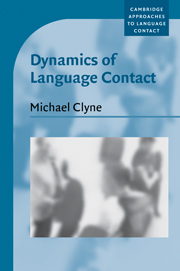Book contents
- Frontmatter
- Contents
- List of map and figures
- List of tables
- Series editor's foreword
- Acknowledgments
- List of abbreviations
- 1 Introduction
- 2 Dynamics of language shift
- 3 On models and terms
- 4 Dynamics of convergence and transference
- 5 Dynamics of transversion
- 6 Dynamics of plurilingual processing
- 7 Dynamics of cultural values in contact discourse
- 8 Towards a synthesis
- Notes
- References
- Index of authors
- Index of languages
- Index of subjects
3 - On models and terms
Published online by Cambridge University Press: 18 December 2009
- Frontmatter
- Contents
- List of map and figures
- List of tables
- Series editor's foreword
- Acknowledgments
- List of abbreviations
- 1 Introduction
- 2 Dynamics of language shift
- 3 On models and terms
- 4 Dynamics of convergence and transference
- 5 Dynamics of transversion
- 6 Dynamics of plurilingual processing
- 7 Dynamics of cultural values in contact discourse
- 8 Towards a synthesis
- Notes
- References
- Index of authors
- Index of languages
- Index of subjects
Summary
Introduction
In this chapter, I will attempt to provide a context for the corpus-based discussion of some of the dynamics of convergence. Models, terminology and the preoccupations of recent research literature will be explored and a rationale proposed for my own treatment of language contact phenomena.
The troublesome terminology around ‘code-switching’
Before we discuss various theoretical frameworks, let us consider what ‘code-switching’ has come to mean. There are three main ways of conceptualizing code-switching:
in contrast to ‘borrowing’;
subsuming ‘borrowing’;
with indexical (or other discourse) function only, for instance indicating group membership or ‘otherness’ (in conversational analysis, in contrast to language switching).
Ever since Haugen (1953) gave prominence to ‘switching’, it has been customary to differentiate between ‘borrowing’ (also called ‘importation’) and ‘switching’ (Haugen 1956: 50 actually worked with a trichotomy ‘importation’/‘integration’/‘switching’). Gumperz (1964) introduced the term ‘code-switching’ for switching with a discourse function (see below, section 2.5.6). However, over time it was employed increasingly for any kind of switching, irrespective of its functions. ‘Code’ there simply means ‘language’ or ‘variety’. However, some conversation analysts (e.g. Alvarez-Caccámo 1998; Meeuwis and Blommaert 1998) have recently reclaimed the term and advocate making explicit the distinction between code-switching, where the code and the switch have emblematic meaning and discourse functions, and language or variety switching or alternation where the ‘codes’ and the ‘switch’ may not necessarily be communicatively meaningful.
- Type
- Chapter
- Information
- Dynamics of Language ContactEnglish and Immigrant Languages, pp. 70 - 102Publisher: Cambridge University PressPrint publication year: 2003



